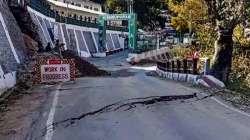Uttarakhand: Rishikesh-Badrinath National Highway shows fresh signs of subsidence after crack emerges
The stretch located between Chamoli and Nandprayag near Pursari village is apparently sinking towards the Alaknanda River.

A stretch about 50 metres long on the Rishikesh-Badrinath National Highway is beginning to crack and showing signs of land subsidence in Uttarakhand. According to reports, the stretch located between Chamoli and Nandprayag near Pursari village is apparently sinking towards the Alaknanda River. Authorities have issued a "go-slow warning" to motorists coming from the mountainside because of the alarming situation.
A police team has also been deployed on the affected spot to alert the drivers. Traffic Inspector Praveen Alok said that the subsidence-sensitive spot has been demarcated with reflective tapes for the safety of vehicles and drivers are being asked to drive carefully.
Land subsidence increased after Kedarnath disaster
According to reports, land subsidence near Pursari increased after the Kedarnath disaster in 2013. As a result, the government launched a road stabilisation project, enlisting major corporations and local experts, spending millions of rupees to build concrete blocks along the Alaknanda's banks, which caused the subsidence to cease. However, the place is showing signs of erosion again.
The engineers of the National Highways Authority of India are making efforts to repair the landslide-prone area by filling the cracks with soil and stones, a government official said.
Heavy rains led to fresh landslides
Heavy rain this monsoon has not only led to the emergence of fresh landslide points along the highway but has also activated old ones due to which the traffic is getting disrupted frequently, he said.
National Highways and Infrastructure Development Corporation Limited (NHIDCL) General Manager Shailendra Kumar, who is involved in the construction of the National Highway in the area, said that to prevent landslides, concrete blocks had been constructed on the banks of the Alaknanda which had stopped the erosion of the river. The road had since been stable but the rise in the water level in the Alaknanda is making water flow over the concrete blocks which may have led to increased subsidence in the area, Kumar added.
(With PTI inputs)
ALSO READ: Watch Video: Dehradun Defence College building collapses due to heavy rain in Uttarakhand